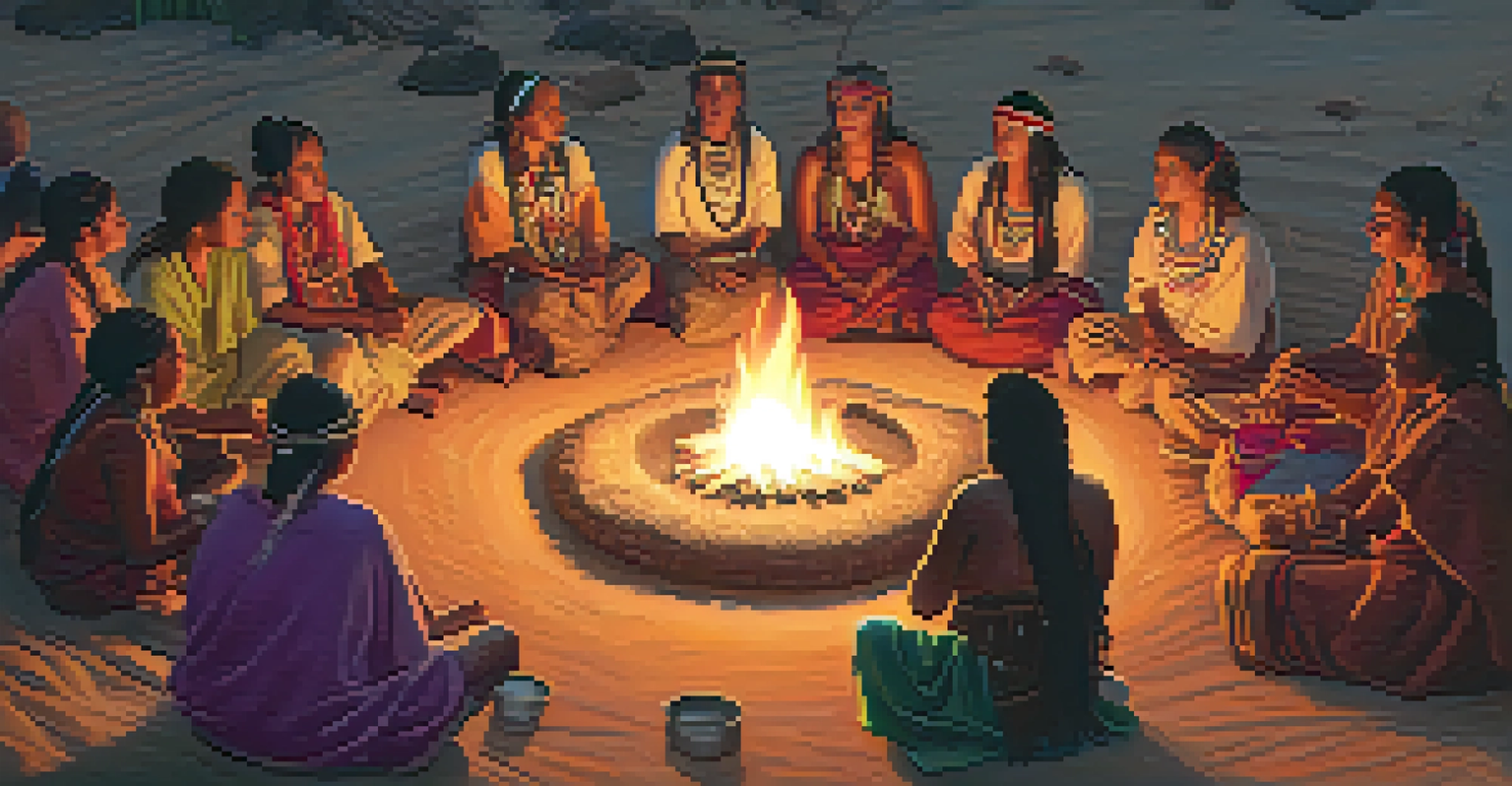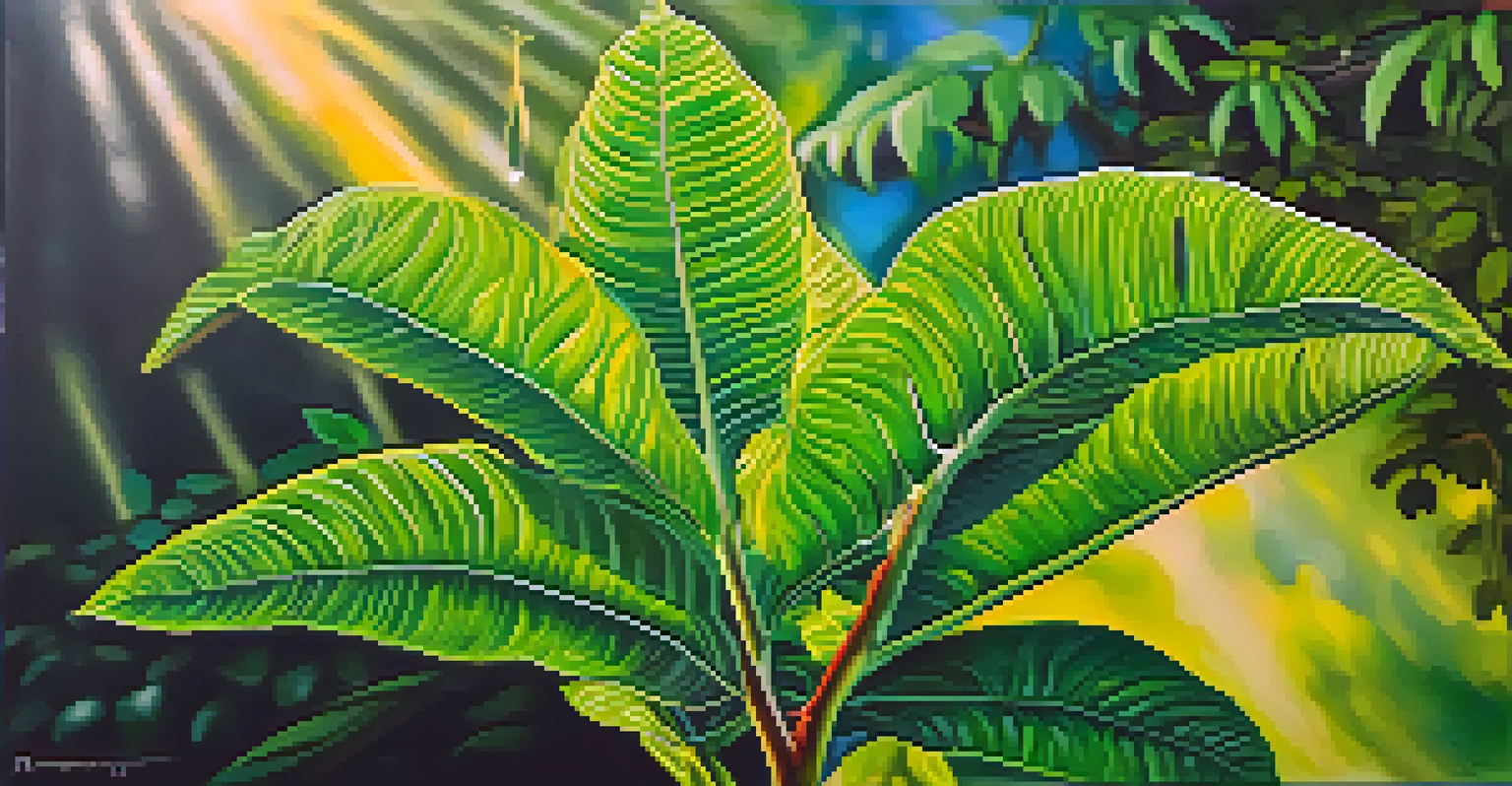The Historical Use of Entheogens in Indigenous Healing Rituals

Understanding Entheogens and Their Role
Entheogens are substances that inspire a feeling of connection to the divine. Historically, they have been used in various cultures to facilitate spiritual experiences and healing. These plant-based or synthetic substances play a crucial role in many indigenous healing rituals, where they are often intertwined with cultural identity and practices.
The use of entheogens is a sacred door that leads us to the heart of our existence and the mysteries of the universe.
In indigenous communities, the use of entheogens is typically guided by shamans or healers, who possess the knowledge to harness their healing properties. They are viewed not merely as tools for intoxication but as sacred elements that open portals to deeper understanding and healing. This perspective emphasizes the symbiotic relationship between nature and spirituality.
The rituals surrounding entheogen use often include music, dance, and communal participation, creating a holistic environment that enhances the effectiveness of the experience. Such practices highlight the importance of context, intention, and community in achieving healing through these substances.
Historical Context of Entheogen Use
The use of entheogens dates back thousands of years, with evidence found in ancient texts and archaeological sites. For example, the use of peyote among Native American tribes has been documented for centuries, showcasing its significance in religious and healing contexts. Similarly, ayahuasca has been utilized by Amazonian tribes as a means to connect with the spiritual realm.

These historical practices have been passed down through generations, often tightly woven with the community's traditions and identity. The rituals not only serve to heal physical ailments but also address emotional and spiritual imbalances, highlighting the holistic approach of indigenous healing. This long-standing heritage emphasizes the value placed on ancestral wisdom and the continuity of cultural practices.
Entheogens Foster Spiritual Connection
Entheogens are revered in indigenous cultures for their ability to facilitate deep spiritual experiences and healing.
As modern society begins to recognize the therapeutic potential of entheogens, there is a growing interest in understanding these historical contexts. This exploration allows us to appreciate the depth of knowledge and practices that indigenous cultures have cultivated over millennia, often leading to more respectful and informed approaches in contemporary settings.
The Shamanic Role in Healing Rituals
In many indigenous cultures, shamans are revered as spiritual leaders and healers who guide the use of entheogens. Their role extends beyond mere administration of substances; they are responsible for setting intentions and creating a safe space for participants. This guidance is crucial, as the experiences can be intense and transformative.
Indigenous wisdom and practices offer a lens through which we can better understand our relationship with nature and ourselves.
Shamans often use a variety of techniques, such as chanting, drumming, or dancing, to facilitate the healing process. These practices help to elevate the participants' experiences, allowing them to connect more deeply with the entheogen and their own inner landscapes. This orchestration of elements reflects a profound understanding of the human psyche and its relationship with nature.
Moreover, the shaman's connection to the community reinforces the social aspect of healing. Participants often share their experiences in a group setting, fostering a sense of belonging and mutual support. This communal approach not only aids individual healing but also strengthens the fabric of the community as a whole.
Cultural Significance of Entheogens
Entheogens hold immense cultural significance in many indigenous societies. They are often seen as sacred gifts from the earth, integral to the community's spiritual practices and worldview. This reverence fosters a deep respect for nature and an understanding of interconnectedness within the ecosystem.
For many tribes, entheogens are not just tools for healing; they embody ancestral wisdom and teachings. The rituals surrounding their use often narrate stories of creation, identity, and spirituality, reinforcing the community's values and beliefs. This cultural context enriches the experience, making it a profound journey of self-discovery and connection.
Entheogens in Indigenous Healing
Entheogens are sacred substances used in indigenous cultures for spiritual connection and holistic healing.
Incorporating entheogens into healing rituals also serves to preserve cultural heritage. As globalization and modernization threaten traditional practices, these rituals become a means of resistance and continuity. By honoring their ancestors' wisdom, communities assert their identity and cultural legacy in the face of change.
Modern Perspectives on Indigenous Practices
In recent years, there has been a resurgence of interest in entheogens, leading to a re-evaluation of their role in healing and spirituality. This modern perspective often intersects with indigenous practices, prompting important discussions about cultural appropriation and respect for traditional knowledge. Many advocates emphasize the need for authentic engagement with indigenous communities.
As scientists explore the therapeutic benefits of entheogens, such as psilocybin and MDMA, there is potential for integrating these substances into modern mental health treatment. However, this integration must be approached thoughtfully, ensuring that the cultural roots and significance of these practices are honored. Collaboration with indigenous healers can provide valuable insights into the respectful use of these substances.
This dialogue between ancient wisdom and modern science highlights the importance of maintaining cultural integrity while exploring new avenues for healing. By recognizing the legitimacy of indigenous knowledge, we can foster a more holistic approach to mental health that values diverse perspectives and practices.
Challenges Facing Indigenous Healing Practices
Despite the growing interest in entheogens, indigenous healing practices face significant challenges. One major issue is the commodification of these substances, where their sacred use is often overshadowed by their popularity in recreational contexts. This commercialization can lead to a dilution of their spiritual significance and the exploitation of indigenous cultures.
Furthermore, many indigenous communities struggle with the impacts of colonization, which have disrupted traditional practices and access to their sacred lands. This disconnection from their heritage can hinder the transmission of knowledge and the practice of rituals that have been vital for their identity and healing. Protecting these practices is essential for the survival of their cultural integrity.
Shamans Guide Healing Practices
Shamans play a crucial role in facilitating entheogenic experiences, creating intentional spaces for communal support.
Advocacy for indigenous rights and the protection of traditional practices is crucial in addressing these challenges. By supporting indigenous communities and promoting their voices, we can work towards a future where entheogenic practices are respected and preserved within their cultural contexts.
The Future of Entheogenic Healing
As society becomes more open to the potential benefits of entheogens, the future of these practices looks promising. Increased research and acceptance could lead to a renaissance of traditional healing methods, allowing indigenous communities to reclaim their practices. This revitalization could empower these cultures and encourage the sharing of their wisdom with the world.
However, this future hinges on a commitment to ethical practices and respect for indigenous knowledge. It is vital that as we explore these substances, we do so with humility and a willingness to learn from those who have used them for generations. Building partnerships with indigenous healers can create pathways for mutual understanding and respect.

Ultimately, the future of entheogenic healing lies in a balanced approach that honors tradition while embracing innovation. By fostering respectful dialogue and collaboration, we can create a more inclusive understanding of healing that benefits both individuals and communities.